| |
Printer-friendly version (HTML) |
A Look at Wages in Transportation-Related Occupations in the Memphis Area and in the United States
by Eli R. Stoltzfus
Bureau of Labor Statistics
Originally Posted: February 25, 2008
The Memphis metropolitan area1 boasts a concentration of transportation industries. This is not surprising, due to its central location in the United States and its well-developed transportation infrastructure. Two of the busiest trucking corridors in the United States--Interstate 40 and Interstate 55--intersect in Memphis, and large cities such as Atlanta, Chicago, and Dallas are only a day’s drive away. In addition, Memphis has one of the world’s largest air cargo hubs and several major railroad operations. The ports on the Mississippi River add to the transportation infrastructure in the area.2 These natural features and man-made corridors provide incentive for transportation industry establishments to locate in Memphis.
The proportion of private industry workers who are in trade, transportation, and utilities industries is higher for Memphis than it is for the United States overall. (All figures in this article are for private industry workers only.) In 2006, 32 percent of all workers in the Memphis area were employed in trade, transportation, and utilities industries, compared with 23 percent of all U.S. workers.3 Moreover, the latest available BLS data indicate that, in February 2007, 14 percent of private industry workers in the Memphis area were employed in transportation and material moving occupations and 20 percent were employed in office and administrative support occupations; for the United States as a whole, the comparable figures are 9 percent and 17 percent, respectively, in June 2006.4
An industry’s concentration in an area, measured by the percentage of all workers in the area who are employed in the industry, may be higher than average due to factors such as central location and the availability of infrastructure. Such factors may give firms in the industry in that area an advantage compared with similar firms elsewhere. Other things being equal, firms will be attracted to an area if the capital and labor costs of producing products or services are lower in that area relative to another area. Over time, as more firms in a specific industry locate to a particular area, one consequence may be relatively higher wages for the jobs crucial to the mission of those firms.5
Given the relatively high percentage of workers in transportation and material moving occupations and office and administrative support occupations in the Memphis area, do workers in these occupational groups receive higher wages than their counterparts across the Nation? In particular, how do they fare in the trade, transportation, and utilities industries compared with those in all private industry? One might expect that wage rates in the Memphis area for occupations that the transportation industry relies upon heavily would be significantly greater than in the United States as a whole and that wage rates for occupations not specific to the transportation industry would be statistically the same as for the United States. This article examines these questions using data from the National Compensation Survey (NCS).
Within a given occupation or occupational group, hourly earnings vary by work level; there are different rates of pay for different levels of skills and responsibilities required to do a job. (See Exhibit 1 for an explanation of work levels.) Usually, the higher the work level, the higher the hourly rate of pay. Earnings by work level are an indication of the impact that specific knowledge, such as how to operate a tractor-trailer truck, can have on a worker’s rate of pay. (In the rating system used by the NCS, tractor-trailer drivers generally are evaluated at a minimum of work level 4.) Competition among firms for jobs at certain work levels can also have an impact on pay at those work levels.
The charts that follow compare average wage rates for occupations in the Memphis area with those in the United States as a whole; they show comparisons for jobs that require skills that the transportation industry relies upon to get its work done, as well as for jobs that are not specific to the transportation industry. The charts also show hourly earnings by selected occupational work levels and occupational subgroups. The last chart in the presentation shows hourly earnings estimates for transportation and material moving occupations and for office and administrative support occupations in trade, transportation, and utilities industries in the Memphis area and in the United States. The estimates for the Memphis area have a reference month of February 2007, and the estimates for the United States have a reference month of June 2006.6
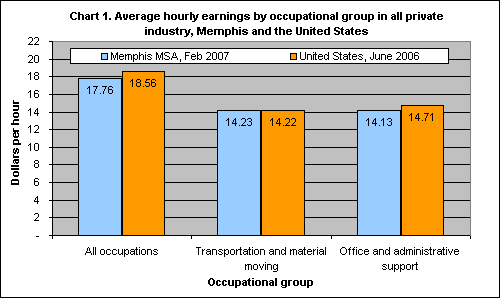
- Chart 1 shows that in the Memphis area, the average hourly earnings for all occupations ($17.76), for transportation and material moving occupations ($14.23), and for office and administrative support occupations ($14.13) were close to the average hourly earnings for the same occupational groups in the United States.
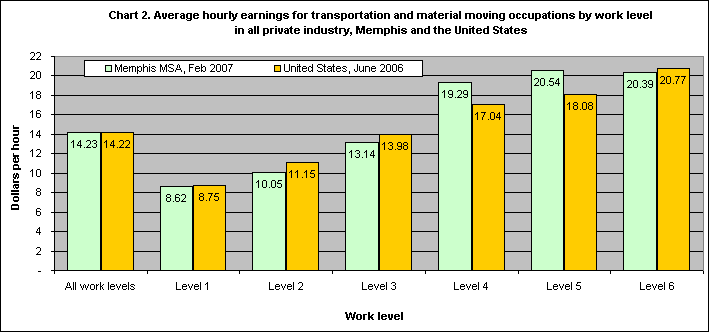
- Chart 2 shows average hourly earnings by occupational work level. For transportation and material moving occupations in the Memphis area, the average hourly wage ranged from $8.62 for work level 1 (entry level) to $20.54 for work level 5 and $20.39 for work level 6.
- Chart 2 also shows that for transportation and material moving occupations in the Memphis area, average hourly wages for work level 4 ($19.29) and work level 5 ($20.54) were significantly higher than the average for these workers in the United States as a whole.7 A large portion of workers in level 4 and level 5 are in occupational subgroup driver/sales workers and truck drivers, jobs that require higher levels of skill and responsibility and often require special certification, such as a commercial driver’s license. These are relatively high paying jobs, as shown in chart 3.
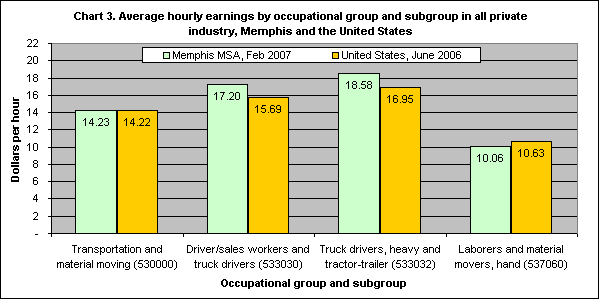
- Chart 3 shows that the average hourly wage rate for driver/sales workers and truck drivers was $17.20 in the Memphis area, compared with $15.69 in the United States as a whole.
- Chart 3 also shows that the average hourly wage for truck drivers, heavy and tractor-trailer, was $18.58 in the Memphis area, compared with $16.95 in the United States as a whole.
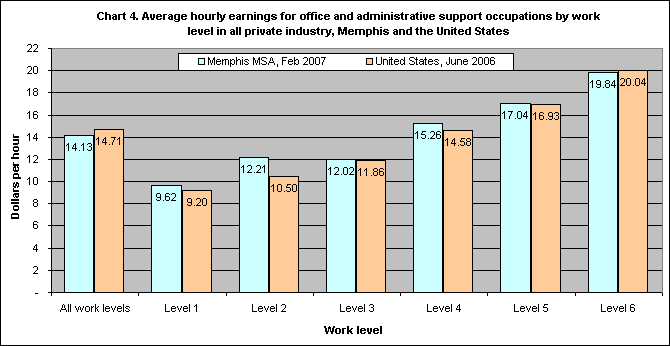
- Chart 4 shows average hourly earnings by occupational work level. For office and administrative support occupations in the Memphis area, the average hourly wage ranged from $9.62 for work level 1 (entry level) to $19.84 for work level 6.
- Chart 4 also shows that for office and administrative support occupations in the Memphis area, average hourly earnings for work levels 1 through 6 generally were close to the average hourly earnings for work levels 1 through 6 in the United States.
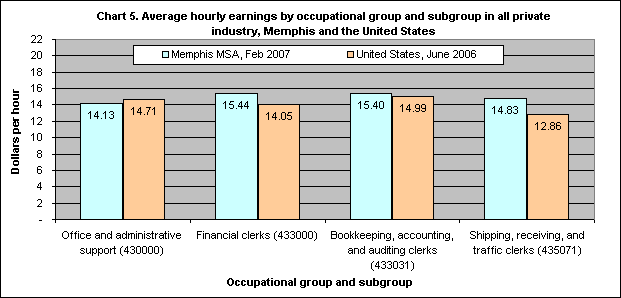
- Chart 5 shows that the average hourly wage for financial clerks was $15.44 in the Memphis area, which is significantly higher than the rate of $14.05 received by similar workers in the United States as a whole; and the average hourly wage for bookkeeping, accounting, and auditing clerks was $15.40 in the Memphis area and $14.99 the United States.
- Chart 5 also shows that the average hourly wage for shipping, receiving, and traffic clerks was significantly higher in the Memphis area ($14.83) than in the United States as a whole ($12.86).
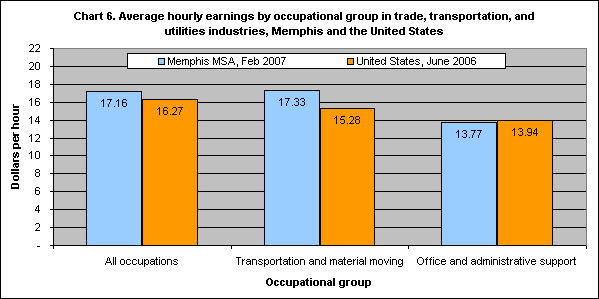
- Chart 6 shows that in trade, transportation, and utilities industries, the average hourly wage for all occupations was $17.16 in the Memphis area and $16.27 in the United States as a whole.
- Chart 6 also shows that in the trade, transportation, and utilities industries, the average hourly wage for transportation and material moving occupations was $17.33 in the Memphis area, compared with $15.28 in the United States as a whole.
In sum, National Compensation Survey data show that, in most cases, workers in the Memphis area in the occupational groups studied earned close to the national average in private industry overall and in trade, transportation, and utilities industries. As noted in the charts, there are work levels at which workers in the Memphis area earned significantly more than their counterparts in the Nation as a whole: workers in transportation and material moving occupations, work level 4 and work level 5; and two groups of office and administrative support occupations--financial clerks and shipping, receiving, and traffic clerks. (See charts 2 and 5.)
Exhibit 1
National Compensation Survey Methodology
The data presented in this article make distinctions between workers in different occupations and industries, and at different work levels. This information is collected by a field economist in an interview with employers, who provide data for the survey. Wage rates are collected in a variety of forms, depending on the method of pay used by the establishment, such as weekly or monthly rates, or base pay and incentive pay. Wage rates collected are straight-time earnings and do not include overtime. The field economist also collects information on employee work schedules. Work schedule information is needed to calculate the straight-time average hourly wage rate for an occupational group.8
To determine the work level, each occupation is evaluated using a point-factor leveling process, which evaluates four aspects of a job: knowledge, job controls and complexity, contacts, and physical environment. The knowledge factor is tailored to 24 families of closely related jobs. Points are assigned based on the occupation’s rank within each factor. The points are summed to determine the overall level of the occupation; the levels range from level 1 to level 15.9
It is important to distinguish between industries and occupations within industries. An industry provides products or services. For example, the construction industry builds roads and houses; the transportation industry provides freight shipping services to shippers and receivers of goods. An occupation, on the other hand, is a set of activities or tasks that employees are paid to perform, and a given occupation could be found in many different industries. For example, truck drivers operate trucks and clerks perform office tasks, whether employed by the construction industry or by the transportation industry.
Occupational Pay Relatives
Throughout the United States wage rates differ across local areas, or localities. While overall wage rates in the Memphis area are close to those in the United States as a whole, generally they are lower relative to wage rates in New York, NY, and higher relative to Brownsville, TX, for example.
For 2005 and 2006, the National Compensation Survey published estimates on occupational pay relatives for 9 major occupational groups in 78 metropolitan areas and for the United States as a whole. Pay relatives provide a means of comparing relative pay differences across occupations and areas. The pay relatives for occupational groups in a metropolitan area express average pay as a percent of pay for comparable occupational groups in the United States; pay relatives for the United States as a whole are always equal to 100. The methodology used in computing pay relatives takes into account factors such as occupational composition, work levels, work schedules, and reference dates. In 2006, for all civilian workers, the occupational pay relative for all occupations in the Memphis area was 95, which means that, on average, workers in the Memphis area earned approximately 5 percent less than workers in the United States as a whole.10
Eli R. Stoltzfus
Economist, Division of National Compensation Survey, Office of Field Operations, Bureau of Labor Statistics.
Telephone: (202) 691-6506; E-mail: Stoltzfus.Eli@bls.gov
Notes
1 The Memphis Metropolitan Statistical Area (MSA), referred to in this article as the "Memphis area," includes the counties of Fayette, Shelby, and Tipton, in Tennessee, as well as Crittenden County, Arkansas, and Desoto County, Mississippi.
2 David Biederman, "Logistics Long Roots," Traffic World, November 20, 2006.
3 Employment data are from the BLS Quarterly Census of Employment and Wages (QCEW), 2006 annual averages, private industry. For more information, see Location Quotient Calculator, available on the Internet at http://data.bls.gov/LOCATION_QUOTIENT/servlet/lqc.ControllerServlet.
4 The following table shows the number of workers represented in the National Compensation Survey (NCS):
The numbers of workers represented by the survey are rounded to the nearest 100. Estimates of the number of workers provide a description of size and composition of the labor force included in the survey. Estimates are not intended, however, for comparison to other statistical series to measure employment trends or levels. For more information on the data for Memphis, see Memphis, TN-AR-MS, National Compensation Survey, February 2007, Bulletin 3135-61 (Bureau of Labor Statistics, June 2007), appendix A, table 1; available on the Internet at http://www.bls.gov/ncs/ocs/sp/ncbl0914.pdf. For more information on the data for the United States as a whole, see National Compensation Survey: Occupational Earnings in the United States, 2006, Bulletin 2590 (Bureau of Labor Statistics, September 2007), appendix A, table 1; available on the Internet at http://www.bls.gov/ncs/ncswage.htm.
Occupations are classified using the Standard Occupational Classification (SOC) system (available on the Internet at http://www.bls.gov/soc/home.htm). The SOC uses a six-digit hierarchical classification system that categorizes more than 800 individual occupations into 23 major groups. The occupational groups analyzed in this study are coded as follows:
Transportation and material moving (53-0000)
Driver/sales workers and truck drivers (53-3030)
Truck drivers, heavy and tractor-trailer (53-3032)
Laborers and material movers, hand (53-7060)
Office and Administrative Support (43-0000)
Financial clerks (43-3000)
Bookkeeping, accounting, and auditing clerks (43-3031)
Shipping, receiving, and traffic clerks (43-5071)
Industries are classified using the North American Industry Classification System (NAICS). NAICS is an industry classification system that groups establishments into industries based on the products or services produced by the establishments. Industries are classified into 20 two-digit sectors. Trade, Transportation, and Utilities Industries include sectors 22, 42, 44, 45, 48, and 49. See North American Industry Classification System--United States, 2002, (Executive Office of the President, Office of Management and Budget, 2002). The BLS NAICS page can be accessed at http://www.bls.gov/bls/naics.htm.
5 See Maury B. Gittleman, "Pay relatives for metropolitan areas in the NCS," Monthly Labor Review, March 2005, pp. 46-53; available on the Internet at http://www.bls.gov/opub/mlr/2005/03/art4full.pdf.
6 For the Memphis MSA, data were collected between December 2006 and April 2007; the average reference month is February 2007. For the United States, data were collected between December 2005 and January 2007; the average reference month is June 2006. The collection reference date can affect outcomes: due to certain economic factors, such as inflation, wage rates with a reference date at the beginning of a year tend to be lower than wage rates with a reference date at the end of the same year.
7 "Statistical significance" describes a mathematical measure of difference between estimates. In this article, values are described as "significantly higher" than other values if they pass a test of statistical significance.
8 William J. Wiatrowski, "A Formidable New Compensation Tool: Bureau of Labor Statistics’ New National Compensation Survey," Compensation and Benefits Review, September 1, 1998, pp. 29-41.
9 See "National Compensation Survey: A Guide for Evaluating Your Firm’s Jobs and Pay" (Bureau of Labor Statistics, October 2003); available on the Internet at http://www.bls.gov/ncs/ocs/sp/ncbr0004.pdf.
10 See NCS Published Pay Relatives by Areas, on the Internet at http://www.bls.gov/ncs/ocs/payrel.htm.